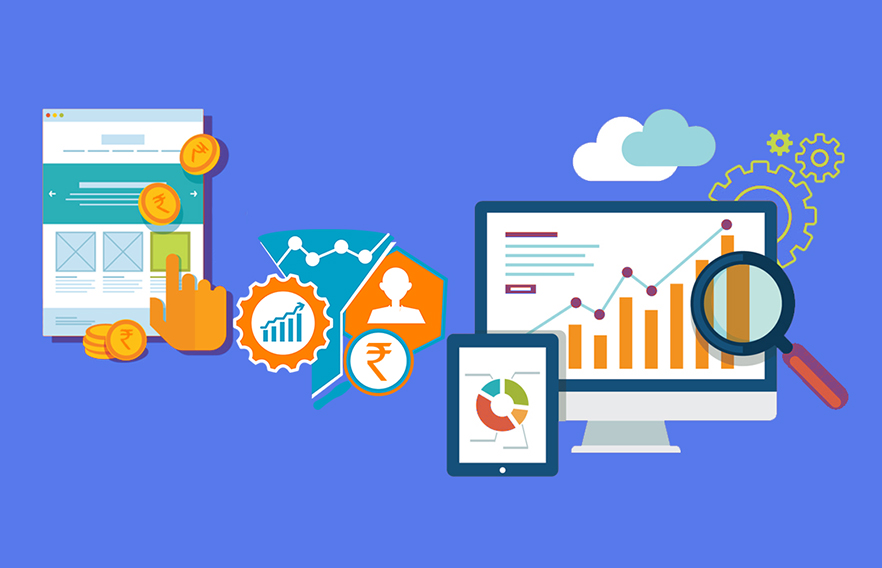The Digital World
One of the defining trends in the recent years has been the colonization of the real by the digital. The rise of social media, smart phones, e-mails and blogging clearly indicate that the world is moving more and more towards digital.
With an increasing number of businesses going digital in order to reach more customers, empower them, reduce cost, and save time, they have a need to invest more on Digital Marketing activities such as Search Engine Marketing (SEM), display targeting, social medial advertising, email campaigns to increase traffic to their websites. While attracting customers has become easier, converting them and engaging them during their visit is still challenging and can widely vary depending on nature of business. Brands also need to think through the entire customer lifetime value and how data can be used to rethink the customer journey. We do have an interesting blog on how data can help improve success of marketing campaigns, which you may find useful.
Conversions and Optimization
“Every aspect of marketing is entirely useless unless it produces conversions,” says Jeremy Smith, conversion consultant, in his book Marketing Land. A conversion can be as simple as an email newsletter subscription to account creation or making a purchase, downloading app etc.
Conversion rate is the percentage of visitors to the website who take an action. Businesses can boost their sales without increasing the marketing spend by optimizing the conversion rates. This can be done by evaluating the sales funnel of their website and improving its effectiveness. Conversion Rate Optimization (CRO) is a structured and systematic approach to improve the website performance and revenue, powered by actionable insights and user feedback.
Few key factors that conversion rate hinges on are:
• The relevance between the webpage content and the visitor’s expectation
• The Value Proposition being offered to the visitors
• The Clarity of main message and call-to-action
• The offers, tone and presentation that enable visitors to take action
Quality of conversions is essential
Optimizing conversion is important, but it is essential to understand that for many visitors conversion is a process. Businesses can aid the visitors to take an action by removing the barriers in their way, but ultimately, the visitors will have to take that final leap for a conversion to happen. The goal is not only to drive traffic to the website or manipulating visitors to convert, but also acquiring loyal and engaged users.
Avoiding the common mistakes
• Making the website cleaner and more modern might have turned out to be successful for one business , but does not guarantee the same for another
• Webpages designed to contain their information within a page, so that the user does not need to scroll can lead to uncertain conversions. Genuinely interested visitors will convert as long as the content is succinct and engaging
• Making changes to the website, without testing the importance of a particular page or page element in influencing the decision making of users, can degrade current conversions rather than optimizing it
• CRO done based on tests that ended sooner than required can turn out to be successful for a short term, but will fail over time, impacting the long-term engagement
Strategize and Execute
Businesses can strengthen their sales funnel significantly by following the below three-step approach:
Set Goals and Track:
Decide the conversion to be measured and optimized – generating leads, driving downloads, promoting products, starting a trial version or completing a purchase. Do not lose focus on macro goals such as revenue realization while optimizing micro goals.
The discovery of what matters is important as that will help figure out what to optimize and how. Use behavior analytics such as heat maps, visitor recordings, on-page surveys and form analysis to find what is stopping or enhancing visitors to convert.
While defining the conversion goals, businesses should also pay attention to other metrics such as visitor recency and visitor loyalty apart from measuring plain conversion rate. Customer lifetime value is a critical aspect to track as well.
Hypothesize and Test:
Form hypotheses and perform A/B Testing or Multivariate Testing based on the nature of business, type of goal and historical data. Sometimes it is also a good idea to request website feedback from customers. This will help in evaluate the bounce rate and exit rate at each stage of the conversion funnel.
Estimate the traffic needed and duration of test to achieve statistically significant results and stick to it.
Analyze and Iterate:
Evaluate the site loading speed for every page element change being implemented. Site speed is an essential aspect of optimization. Test results from a poor load quality site might be statistically significant, but the conversion results will be misleading as the traffic to the site is skewed
Starting with what matters the most, analyze each test result to uncover deeper insights into how users behave on website and the best way to guide them through the funnel. Test everything – just not all at once. Understand how different changes interact and impact the conversions.
While CRO can make your sales funnel by lowering customer acquisition costs and maximizing profits, it can also break the funnel when executed without effective strategy and there is always room for improvement.
The concepts discussed here are few of the common CRO scenarios involving analytics. To know more, email: marketing@latentview.com.




